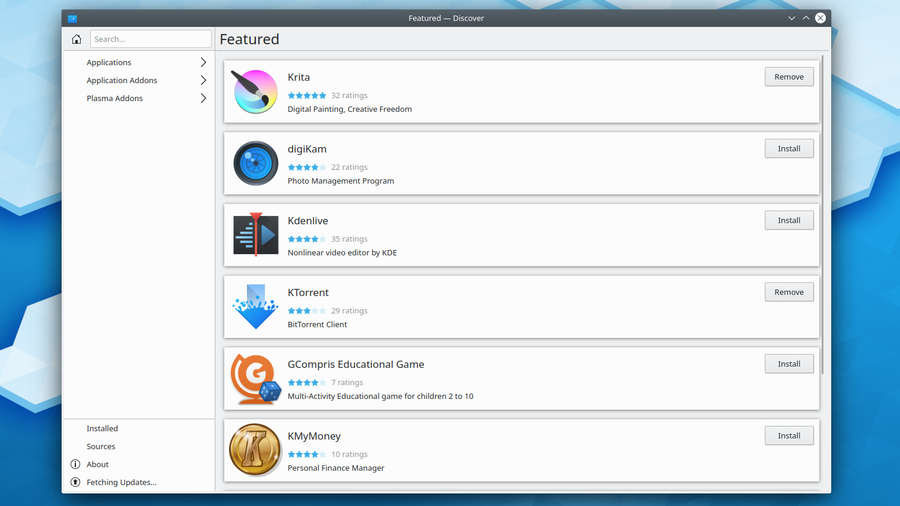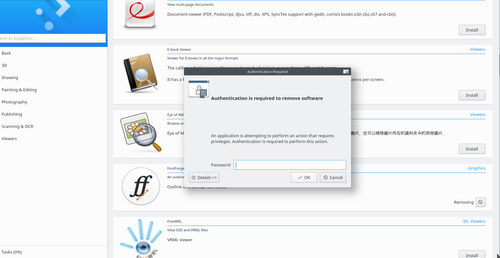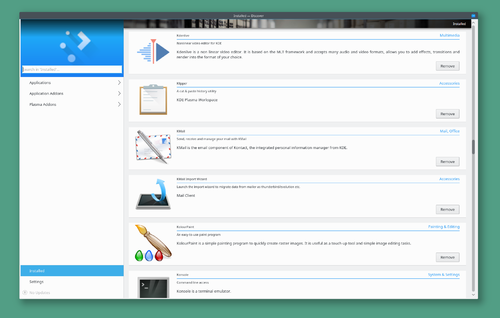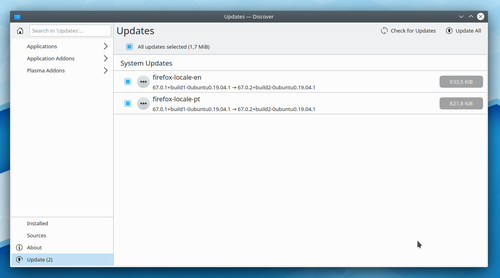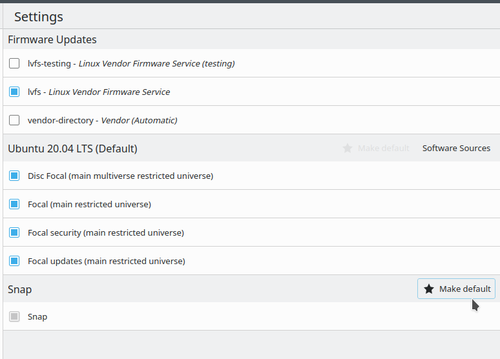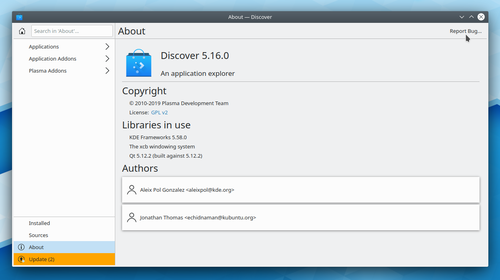Discover
Velkommen til Discover
Et installationsprogram til det 22. århundrede
Discover er din nye "one-stop-shop" til alt, hvad der har med programmer og tilføjelser at gøre. Den er designed fra grunden af til at være nem for brugere at håndtere og let for distributioner at integrere. Her sætter brugerens færdighedsniveau ikke grænser for, hvilke handlinger hun kan foretage, når hun installerer nye programmer og tilføjelser!
Discover blev designet fra grunden af til at være tydelig og let at anvende. Den er baseret på den nye Kirigami-teknologi, ny teknologi til at distribuere programmer samt det sikre system med softwarearkiver til at skabe et program til alle distributioner og alle grader af erfaring - et program som er en fornøjesle at bruge.
Hvad er Discover
Discover er beregnet til brugere og distributione, når terminalen ikke er den optimale måde at installere programmer og tilføjelser eller opdateringer - hvor vi har brug for noget, der er intuitivet og enkelt og frem for alt sikkert at bruge.
Vi har alle prøvet det: at kopiere en kommando fra et websted; og pludselig har vi ødelagt hele vores installation. For en bruger - særligt en ny eller mindre erfaren bruger - er det katastrofalt, og det er ikke let at finde ud af, hvor fejlen opstår: er det et skummelt websted eller din distribution. \
Discovers fokus er at give dig mulighed for at gå på opdagelse blandt tilgængelige programmer, teste dem og opdatere din installation ude frygt for uheldssvangre stavefejl og hvor din tillid bliver respekteret - ikke misbrugt.
Hvad Discover ikke er
Discover kan mange ting, men det er ikke et program til eksperter, som ønsker detaljeret kontrol med arkiver; det er ikke en erstatning for avancerede brugeres brug af terminalen. Vores mål har været et klarere fokus på et udsnit af brugere, som irkelig har brug for sådan et program. For at opnå dette har vi set bort fra andre brugeres behov i programmets design. Det betyder ikke, at de ikke kan bruge Discover - blot at deres behov ikke dækkes fuldstændigt.
Discover er ikke fuldstændigt "børnesikret". Det kan ikke bruges til at kontrollere brugere - vores mål er at give brugere muligheder, og vi prøver at guide dem til sikre valg, men vi tvinger dem aldrig til an handling. Discover vil ikke fratage brugerne deres haldlefrihed.
Hvordan man bruger Discover
Discover er beregnet til at blive brugt - det er designet til at være intuitivt. Prøv det og oplev det selv..
Hvordan man søger efter programmer
Den nemmeste måde at søge efter et program er ganske enkelt at begynde at skrive programmets navn eller dets formål. Søgefeltet er attid aktiveres som udgangspunkt; det er kun nå søgefeltet er gråt at du ikke kan skrive, og når du klikket på det kommer du tilbage til søgetilstanden; så vær ikke bange for tastaturet!
Søgningen foretages altid indenfor den kategori du aktuelt har valgt (dette vises også i teksten i søgefeltet), så husk at navigere til den ønskede kategori før du skriver din døgning.
If you just want to browse or feel unclear on what the application name is or how to best define it in text simply click either "Applications", "Plasma Add-ons", or "Application Add-ons". You will find complete applications in the "Applications" category, Plasma widgets and extensions in "Plasma Add-ons" and extensions for your apps like snippets for coding apps in Application Add-ons.
Let's focus on complete applications for now! Below you can see the category tree that is displayed when you click "Applications". Whenever you want to go back, the "Back" button underneath the search field and in the top of the categories will bring you back to the previous section! From this list of six categories you can go deeper into some categories to display subcategories by clicking them.
By clicking "back" you can always reach the starting point. From here you can continue searching freely. In the column in the middle/to the right in the application you have all installable apps or extensions. When you click them a third column on the right will open with detail info about that application or extension as it is available. You can now scroll through the list and click other apps to display detailed information about them. To remove the right-hand column click on one of the categories in the left column to bring you back to the beginning of your search.
(If you are an app developer and notice that your app has no information or screenshots - see below in "Discover for Devs")
Now try to resize the window. See what happens? Discover, using Kirigami the widget library for convergent apps will react and change to the size of screen you have available. Try resizing it to about the size of a cellphone. It reshapes to better fit that size.
Now to you sitting on a computer this means that if you have a smaller screen the right column will cover the center to give you the user more visual space for the application you chose to get more information on. To get back from that simply hit the back button in the left column!
How to install applications
Installing an application is easy! When you've found the application that you want, simply click the "Install" button in the middle column and it will begin to install. If you are checking out the detailed information like the image below, you can also click "Install" in the bottom right of the right hand column.
Installation with Discover is just as simple as that.
How to uninstall applications
To uninstall apps is just as easy as installing them. Simply find the application that you wish to uninstall in the normal manner - you can note that it has "remove" instead of "install" in the little button next to it. Then click it! All you have to do then is fill in your password and the application is removed directly without fuss.
You can also easily click "Installed" in the left hand column to see all applications and extensions you have installed in your system! That way you can simply scroll through the entire list and look for the app or extensions you wish to uninstall and with ease click "remove". That's all that's needed!
How to upgrade applications
Linux distributions come with upgrades, new releases of apps and system details, bugfixes and improvements. To be able to keep your system up to date and safe Discover has made it easier for you to upgrade. When the update section in the bottom the left column is bright yellow, that means that you have updates waiting for you. Just click it and you will be moved to this screen (you can as usual simply click in another area in the left column to leave it)
In the list you can see all the software that will be updated when you click "Update" at the top right. You can click each individual row to get further information about it. If something is not to your liking, simply uncheck it on the left of the name of the software and it will be held back from the update.
How to master Discover
In this section we will bring up how to handle upgrades, repositories and how to file bugs.
How to handle repositories
Currently Discover focuses on stability and safety and interactions with repositories is beyond the scope of Discover in the current iteration (changing repositories is also potentially dangerous for inexperienced users). Future versions will include a more extensive repository feature and parts of the interface can be tested here.
How to check for Upgrades manually
Sometimes you may want to check the system for updates manually. Discover will check for you automatically, but perhaps you are waiting for something good and want to look to make sure it hasn't arrived yet. In that case go to "Settings" in the left column, click "More" at the top of the middle column and then "Check for updates".
How to file a bug
While usually the user will be interacting with Discover by using the mouse or touch interfaces, it's also possible to navigate it by using the keyboard.
Here's some useful default key combinations:
- Ctrl+F: focus the search text field where we can type
- Back/Forward or Alt+Left/Right: Navigates the panes horizontally
- Enter: opens selected resource on a list
- Up and down arrows: navigate vertical list pages
- Escape: closes the right-most application pane (since Plasma 5.10)

